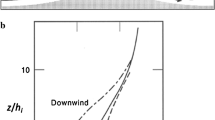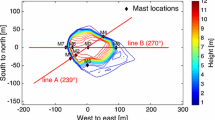Abstract
Four models of surface boundary-layer flow in complex terrain are compared with observations made at Blashaval Hill, North Uist, Scotland. The field experiment is described by Mason and King (1985). Three of the models are derived from the two-dimensional theory of Jackson and Hunt (1975) and are described in Mason and King (1985), Walmsley et al. (1986) and Troen and Petersen (1989). The fourth is a mass-consistent code based on Traci et al. (1979). The model results are in good agreement with each other and are generally within the observed range of variation ( ~ ± 16%) in normalized wind speed. For most wind direcions (7 of 11), model results of normalized wind speed at the summit were within 7% of the observed mean values. For some wind directions, calculations using the “Guidelines” of Walmsley et al. (1989) suggested that variations in surface roughness were important. This led us to apply one of our models incorporating nonuniform surface roughness. The lack of significant improvement for cases when water lay upstream of Blashaval Hill is attributed to compensating changes at summit and reference sites and to very local effects on the wind data. Sensitivity to topography lying to the west and northwest of Blashaval was also investigated. Results suggested an influence from those distant topographic features for some wind directions. When those features were incorporated, maximum errors in normalized wind speed at the summit were reduced from 18 to 13%.
Similar content being viewed by others
References
Jackson, P. S. and Hunt, J. C. R.: 1975, ‘Turbulent Flow Over a Low Hill’, Quart. J. Roy. Meteorol. Soc. 101, 929–955.
Hunt, J. C. R.: 1980, ‘Wind Over Hills’, in: J. C. Wyngaard (ed.), Workshop on the Planetary Boundary Layer, Amer. Meteorol. Soc., Boston, pp. 107–144.
Lalas, D. P.: 1985, ‘Wind Energy Estimation and Siting in Complex Terrain’, Int. J. Solar Energy 3, 43–71.
Mason, P. J. and King, J. C.: 1985, ‘Measurements and Predictions of Flow and Turbulence over an Isolated Hill of Moderate Slope’, Quart. J. Roy. Meteorol. Soc. 111, 617–640.
Mason, P. J. and Sykes, R. I.: 1979, ‘Flow Over an Isolated Hill of Moderate Slope’, Quart. J. Roy. Meteorol. Soc. 105, 383–395.
Panofsky, H. A. and Dutton, J. A.: 1984, Atmospheric Turbulence: Models and Methods for Engineering Applications, John Wiley & Sons, New York, 397 pp.
Sherman, C. A.: 1978, ‘A Mass-Consistent Model for Wind Fields in Complex Terrain’, J. Appl. Meteorol. 17, 312–319.
Sykes, R. I.: 1980, ‘An Asymptotic Theory of Incompressible Turbulent Boundary-Layer Flow over a Small Hump’, J. Fluid Mech. 101, 647–670.
Taylor, P. A.: 1977, ‘Some Numerical Studies of Surface Boundary-Layer Flow Above Gentle Topography’, Boundary-Layer Meteorol. 11, 439–465.
Taylor, P. A. and Lee, R. J.: 1984, ‘Simple Guidelines for Estimating Wind Speed Variations due to Small-Scale Topographic Features’, Climatol. Bull. 18 (2), 3–32.
Taylor, P. A., Mason, P. J. and Bradley, E. F.: 1987, ‘Boundary-Layer Flow Over Low Hills’, Boundary-Layer Meteorol. 39, 107–132.
Taylor, P. A., Walmsley, J. L. and Salmon, J. R.: 1983, ‘A Simple Model of Neutrally Stratified Boundary-Layer Flow Over Real Terrain Incorporating Wavenumber-Dependent Scaling’, Boundary-Layer Meteorol. 26, 169–189.
Traci, R. M., Phillips, G. T., Patnaik, P. C. and Freeman, B. E.: 1977, ‘Development of a Wind Energy Methodology’, U.S. Dept. Energy Rep. RLO/2
Troen, I., Mortensen, N. G. and Petersen, E. L.: 1988, WASP Wind Atlas Analysis and Application Programme. User's Guide, Risø National Lab., Roskilde, Denmark, 32pp.
Troen, I. and Petersen, E. L.: 1989, The European Wind Atlas, Risø National Lab., Roskilde, Denmark, 656pp.
Walmsley, J. L.: 1989, ‘Evaluation of Formulae for the Height of the Internal Boundary Layer Downstream of a Change in Roughness’, Boundary-Layer Meteorol. 47, 251–262.
Walmsley, J. L. and Salmon, J. R.: 1989, ‘MS-Micro/2 User's Manual’, Second Ed. Rep., Canadian Climate Centre, Downsview, Ontario, Canada, 115 pp.
Walmsley, J. L., Salmon, J. R. and Taylor, P. A.: 1982, ‘On the Application of a Model of Boundary-Layer Flow Over Low Hills to Real Terrain’, Boundary-Layer Meteorol. 23, 17–46.
Walmsley, J. L., Taylor, P. A. and Keith, T.: 1986, ‘A Simple Model of Neutrally Stratified Boundary-Layer Flow Over Complex Terrain with Surface Roughness Modulations (MS3DJH/3R)’, Boundary-Layer Meteorol. 36, 157–186.
Walmsley, J. L., Taylor, P. A. and Salmon, J. R.: 1989, ‘Simple Guidelines for Estimating Wind Speed Variations due to Small-Scale Topographic Features-An Update’, Climatol. Bull. 23, 3–14.
Author information
Authors and Affiliations
Rights and permissions
About this article
Cite this article
Walmsley, J.L., Troen, I., Lalas, D.P. et al. Surface-layer flow in complex terrain: Comparison of models and full-scale observations. Boundary-Layer Meteorol 52, 259–281 (1990). https://doi.org/10.1007/BF00122090
Revised:
Issue Date:
DOI: https://doi.org/10.1007/BF00122090




